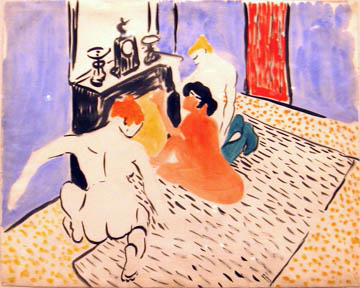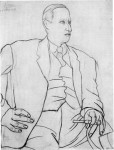
Andre Derain
French, 1880-1954
Three Nudes in Front of a Fireplace, 1904-1905
watercolor and pencil on paper
19 1/4 x 24 1/8 in.
SBMA, Gift of Mary and Leigh Block
1987.58.10

Portrait of Derain , 1919 by Pablo Picasso, Musee Picasso, Paris
RESEARCH PAPER
Among 20th century French artists, André Derain is one of the most difficult to situate in terms of style and personal contribution. First, he was considered, along with Henri Matisse, an inventor of Fauvism around 1905-1906. Then around 1910, many saw him as one of the creators of Cubism. The poet Apollinaire even wrote: “The cubism of Picasso took birth from an art movement that comes from André Derain."1. To make matter even more complicated, during the last part of his career, right after the First World War and a trip to Rome, Derain’s work seems to go against the fundamental principles of Fauvism and Cubism to revert to an almost academic and traditional style. SBMA’s permanent collection includes two works by André Derain that capture well the evolution of his style from the beginning of his career (Three Nudes in front of fireplace) to the end (Ballerina with raised arm). Derain’s painting Still life with pumpkin, 1939 (bequest of Wright S. Ludington), also in our permanent collection, is another example of this artist independence and originality.
Shortly after his discharge from military service in 1904, André Derain returned to painting and created Three Nudes in front of a fireplace. In the summer of 1905, Derain and Matisse were painting together, works that would soon earn them the nickname Les Fauves.
In fact, the critic Louis Vauxcelles, on visiting the Salon d’Automne that year and seeing the recent works by Derain, Matisse, Rouault, Vlaminck, Friesz, Braque and Dufy, called the painters the “Wild beasts” or “Les Fauves”. Hostile critics exploited the pejorative remark and the name stuck. Although Fauvism was a short-lived movement (1905-8), its influence was enormous and international. It helped liberate painting from the representational expectations that had dominated Western art since the Renaissance.
What the art critic reacted to, are the main characteristics of Fauvism that we find in Three Nudes in Front of a fireplace:
Use of color:
Bright, vibrant, pure colors: blue walls, red door, orange hair; Color is used as an expressive end in itself. Pigments are applied arbitrarily, subjectively, in a non-realistic way: green calf & feet! (stockings?)
Crude drawing style:
Composition drawn rapidly just to get the image down (see pencilled lines through the watercolours); Figures with minimal details – faceless bodies; one is more aware of them as shapes than as female bodies, especially the woman in the center. Simplified patterns for the rug, the floor, the objects on the mantel; Thick black lines/outline.
Dramatic brushwork:
Large brush stroke for wall coverage; short, rapid and lively brush strokes for the rug and the floor.
Distorted composition/Odd perspective:
Flat composition from the linear patterns of the floor, rug, fireplace & door and from absence of shadow; View point from behind and above the scene, as if we are peeking at it (the viewer is a fly on the wall); Everything is at an angle: no horizontal lines; the floor appears tilted. Shape of the rug is unrealistic, it’s outline is disjointed almost in a Cezanesque way; Elements of the composition play both a decorative and descriptive role.
Odd depiction of women’s bodies:
Disproportion of body parts: long arms, large feet, small heads; awkward postures; Well developed musculature, almost masculine, which could come from Derain’s interest in and appreciation of African Art and sculpture. One can perceive a sense of illusion, almost fantasy. From the unusual scene itself of these curvy exotic bodies in the middle of an angular, conventional, suspiciously empty room.
From the contradiction between the flatness of the picture, and the suggestion of light and depth evidenced by the color gradation in the dotted floor, brighter in the foreground while darker in the background. At that time around 1904-1906, Derain experimented with a pointillist technique and his paintings became lighter both in color and in touch. The very small brushstrokes the technique demands, calls for a more delicate method. Soon Derain is able to suggest air and light by leaving areas of the canvas unpainted, so that the white ground becomes as much part of the composition as the paint, and creates a sense of fluctuating space. This technique became a tradition in watercolor painting: the white of the paper is the only white used. Opaque paint is seldom used for whites or overpaint.
One can also appreciate the warmth of the fire and of the feminine intimacy contrasting with the vast cold room:
Warm colors of the fire and the flesh of the middle woman proximity of the women with one another “communal” nudity; ease of movement implicit sense of feminine solidarity of their similarly misshaped bodies
size of the rug frames the three nudes together and reinforces their intimacy; short lines of the rug, pointing toward the fireplace, even reaching it, accentuate the women’s attraction to the fire.
Coldness of the room:
Empty of furniture; fireplace and women positioned to the left of the center, creating an increased sense of empty space; cold colored wall covering; objects on the mantel suggest a simple but formal interior décor.
Despite the bold and “wild” handling of form and color, everything is as weightless as possible. Nothing is superfluous. The mood of exubérant lightness and warm sensuality is a visual equivalent of a poetic imagination.
Three Nudes in front of a fireplace represents a lyrical scene, one of the two favoured subjects in Fauve painting; the other one being nature with its landscapes and river scenes.
These numerous contrasts and innovations are the intriguing and fascinating part of the painting and are peculiar to Derain, who, throughout his career, is in a perpetual search for new approaches to his work. The most intelligent and cultivated painters of his generation, he was skilled at bringing his innovation to a level the public could understand. Three Nudes in front of a fireplace and other watercolors Derain painted during the summer of 1905 are possibly the most ambitious and finest he had yet attempted. The more fluid technique loosens his imagination as well as his brush and displays his marvellous achievement at using only the essentials in line and color to achieve his purpose and to illustrate extraordinary animation and vitality.
Once again, the war of 1914 will abruptly interrupt Derain, who had then reached the most inventive and flourishing momentum of his career. His long correspondence with Vlaminck reveals how difficult this period was for him. After the war, Derain discovered the world of theatre and ballet, for which he creatednumerous décor and costumes, before returning once again to painting and drawing. In fact, drawing has been for Derain an activity that he practiced daily in parallel with painting, throughout his entire career.
A dancer’s body is the object Derain studies in Ballerina with raised arm, produced around 1925. This charcoal drawing on paper illustrates well Derain’s evolution of style toward classicism, more specifically the change in his personal conception of line. Derain writes: “Cubism destroyed drawing by cutting to its root the hope for an unknown line."
For Derain, “a line is this path, this trail that elongates and misshapes if it is not exact and constantly more precise."2.
His exploration of the line, indeed his obsession for the model, is not fuelled as much by an idealistic neo-classicism, as by a diligent and disciplined daily practice in the pursuit of “an exact line that is outline, shape, movement and sensation all at the same time." The painter in his studio “sits, kneels, squats, elongates, bends, twists and scrutinises the object." 3.
In Ballerina with raised arm, the fluid and sinuous line that defines her, at times lighter, at other times darker, supports simultaneously the relaxation and the tension her body suggests. One can appreciate the gracious lift of her pose, as well as its heaviness. The carefully observed light caresses unevenly the shapes of the neck, back, shoulders, and arm of the ballerina and gives her an undeniable presence in form and volume.
The impressive, unconventional, almost provocative musculature of Derain’s Ballerina with raised arm, may be influenced by his increased interest in African art at the time. It may also come from his preoccupation with painting the pure and true essence of things, and from his lifelong fascination with what is eternal and non-temporal in painting: space, density, light and movement.
André Derain never sought to please. In half a century, he produced a significant body of work without denying his personal convictions, even though they were not consistent with the historical trend of Modern art. In his work, we can recognize a spirit of audacity and discipline. The diversity of his styles is viewed by some as strength, while others see it as weakness. Ultimately, it reveals Derain’s complex but conscious decision to reconcile western classical tradition with modernity in order to produce an art of all times.
Prepared for the Santa Barbara Museum of Art Docent Council
by Chantal Gariepy, January 7, 2006.
Bibliography
http://en.wikipedia.org/wiki/andré_Derain
http://en.wikipedia.org/wiki/Watercolor_painting
www.artchive.com/artchive/d/derain.html
http://discipline.free.fr/fauvisme.htm
http://fr.wikipedia.org/wiki/Fauvisme
http://www.artcult.com/derain1.htm
Tony Richardson, Nikos Stangos, Concepts of Modern Art, Icon Editions, Harper & Row, 1974, p. 14-32.
Paris Musée, André Derain, Musée d’Art Moderne de la ville de Paris, Nov 18th 1994-March 19th 1995.
Jean Bouret, Hommage a Derain, Exposition du 26 juin au 6 sept. 1975, Gallerie Paul Valloton S.A., Lausane.
Cincinnati Art Museum, An Exhibition of paintings by André Derain, Dec 21, 1930-Jan 18, 1931.
Art Council of Great Britain, Derain, 1967, p. 6-7.
Lee, Jane, Derain. Phaidon Press Limited, Oxford, 1990.
Hopkinson, Martin : Derain. Print Quarterly, vol 21, pt 2, June 2004, pp 175-6.
Sutton, Denys, André Derain, Phaidon Press, London, 1959.
Vaughan, Malcolm, Derain, The Hyperion Press, Harper & Brothers, New York, 1941.
Hilaire, Georges, Derain, Pierre Cailler, Geneve, 1959.
Huyghe, René, French Painting : The Contemporaries, French and European Publications Inc, New York, 1939, pp 21-30.
Lucie-Smith, Edward, Lives of the Great Twentieth Century Artists, Rizzoli, New York, 1986, pp 22-32.
Footnotes
1 « La peinture moderne », 1913, dans G. Apolllinaire, Chronique d ‘Art (1902-1918), L.C. Breunig, Paris, Gallimard, 1960, p. 272
2 R. Gimpel, Souvenirs d’un collectionneur marchand de tableaux, Calmann-Levy, 1963, p. 367.
3 Ph. Dagen, André Derain, dessins inconnus 1901-1954, catalogue de l’exposition du Centre d’art contemporain, Orleans, 1992, ed. A. Maeght, 1992, p. 43-44.
